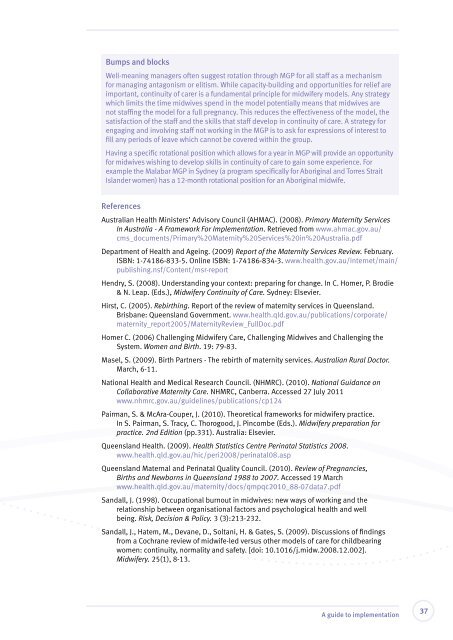Delivering continuity of midwifery care to Queensland women
Delivering continuity of midwifery care to Queensland women
Delivering continuity of midwifery care to Queensland women
You also want an ePaper? Increase the reach of your titles
YUMPU automatically turns print PDFs into web optimized ePapers that Google loves.
Bumps and blocks<br />
Well-meaning managers <strong>of</strong>ten suggest rotation through MGP for all staff as a mechanism<br />
for managing antagonism or elitism. While capacity-building and opportunities for relief are<br />
important, <strong>continuity</strong> <strong>of</strong> <strong>care</strong>r is a fundamental principle for <strong>midwifery</strong> models. Any strategy<br />
which limits the time midwives spend in the model potentially means that midwives are<br />
not staffing the model for a full pregnancy. This reduces the effectiveness <strong>of</strong> the model, the<br />
satisfaction <strong>of</strong> the staff and the skills that staff develop in <strong>continuity</strong> <strong>of</strong> <strong>care</strong>. A strategy for<br />
engaging and involving staff not working in the MGP is <strong>to</strong> ask for expressions <strong>of</strong> interest <strong>to</strong><br />
fill any periods <strong>of</strong> leave which cannot be covered within the group.<br />
Having a specific rotational position which allows for a year in MGP will provide an opportunity<br />
for midwives wishing <strong>to</strong> develop skills in <strong>continuity</strong> <strong>of</strong> <strong>care</strong> <strong>to</strong> gain some experience. For<br />
example the Malabar MGP in Sydney (a program specifically for Aboriginal and Torres Strait<br />
Islander <strong>women</strong>) has a 12-month rotational position for an Aboriginal midwife.<br />
References<br />
Australian Health Ministers’ Advisory Council (AHMAC). (2008). Primary Maternity Services<br />
In Australia - A Framework For Implementation. Retrieved from www.ahmac.gov.au/<br />
cms_documents/Primary%20Maternity%20Services%20in%20Australia.pdf<br />
Department <strong>of</strong> Health and Ageing. (2009) Report <strong>of</strong> the Maternity Services Review. February.<br />
ISBN: 1-74186-833-5. Online ISBN: 1-74186-834-3. www.health.gov.au/internet/main/<br />
publishing.nsf/Content/msr-report<br />
Hendry, S. (2008). Understanding your context: preparing for change. In C. Homer, P. Brodie<br />
& N. Leap. (Eds.), Midwifery Continuity <strong>of</strong> Care. Sydney: Elsevier.<br />
Hirst, C. (2005). Rebirthing. Report <strong>of</strong> the review <strong>of</strong> maternity services in <strong>Queensland</strong>.<br />
Brisbane: <strong>Queensland</strong> Government. www.health.qld.gov.au/publications/corporate/<br />
maternity_report2005/MaternityReview_FullDoc.pdf<br />
Homer C. (2006) Challenging Midwifery Care, Challenging Midwives and Challenging the<br />
System. Women and Birth. 19: 79-83.<br />
Masel, S. (2009). Birth Partners - The rebirth <strong>of</strong> maternity services. Australian Rural Doc<strong>to</strong>r.<br />
March, 6-11.<br />
National Health and Medical Research Council. (NHMRC). (2010). National Guidance on<br />
Collaborative Maternity Care. NHMRC, Canberra. Accessed 27 July 2011<br />
www.nhmrc.gov.au/guidelines/publications/cp124<br />
Pairman, S. & McAra-Couper, J. (2010). Theoretical frameworks for <strong>midwifery</strong> practice.<br />
In S. Pairman, S. Tracy, C. Thorogood, J. Pincombe (Eds.). Midwifery preparation for<br />
practice. 2nd Edition (pp.331). Australia: Elsevier.<br />
<strong>Queensland</strong> Health. (2009). Health Statistics Centre Perinatal Statistics 2008.<br />
www.health.qld.gov.au/hic/peri2008/perinatal08.asp<br />
<strong>Queensland</strong> Maternal and Perinatal Quality Council. (2010). Review <strong>of</strong> Pregnancies,<br />
Births and Newborns in <strong>Queensland</strong> 1988 <strong>to</strong> 2007. Accessed 19 March<br />
www.health.qld.gov.au/maternity/docs/qmpqc2010_88-07data7.pdf<br />
Sandall, J. (1998). Occupational burnout in midwives: new ways <strong>of</strong> working and the<br />
relationship between organisational fac<strong>to</strong>rs and psychological health and well<br />
being. Risk, Decision & Policy. 3 (3):213-232.<br />
Sandall, J., Hatem, M., Devane, D., Soltani, H. & Gates, S. (2009). Discussions <strong>of</strong> findings<br />
from a Cochrane review <strong>of</strong> midwife-led versus other models <strong>of</strong> <strong>care</strong> for childbearing<br />
<strong>women</strong>: <strong>continuity</strong>, normality and safety. [doi: 10.1016/j.midw.2008.12.002].<br />
Midwifery. 25(1), 8-13.<br />
A guide <strong>to</strong> implementation<br />
37
















